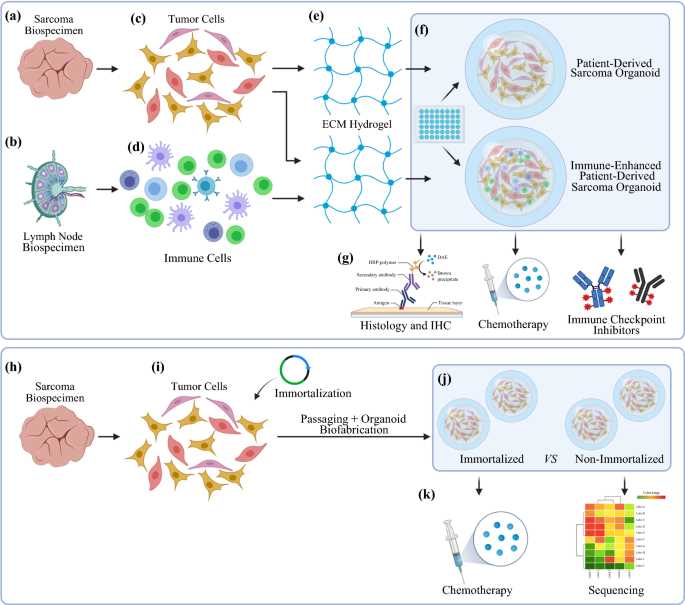All products and services are For Research Use Only and CANNOT be used in the treatment or diagnosis of disease.
Sarcomas are derived from mesenchymal cells and are of high malignancy. Many gene mutations in mesenchymal cells result in more than 200 histological subtypes of Sarcoma in this cancer group. Because of its low incidence rate, there is limited biological material and preclinical models for fundamental and preclinical studies. With the development of stem cell methodology, 3D organoid models are generated to represent specific solid tumors in patients and recapitulate native histopathological and genetic features of tumor tissue.
Creative Biolabs offers a valuable system of cancer organoid cultures retaining the biological characteristics of native tumors for large-scale CAR-cell function evaluation in vitro.
 Fig.1 Sarcoma organoids integrated with the immune system are used for immunotherapy assessment. (Forsythe, et al., 2022)
Fig.1 Sarcoma organoids integrated with the immune system are used for immunotherapy assessment. (Forsythe, et al., 2022)

Culture Medium
The optimal culture medium contains basal medium supplemented with crucial and necessary growth factors and signal molecules to maintain cell culture.
Cell Scaffold
We provide various extracellular matrix (ECM) substitutes as a choice, including Basement membrane matrix, collagen-gel, hydrogel, and so on.
Culture Method
The air-liquid interface method, matrix-overlaid method, and other advanced culture methods can be applied to organoid production.
We perform cytomorphology, immunophenotype, and genomic analysis to explain how the established organoids resemble the original sarcoma and find differences in the model.
| Technique | Description | |
| Phenotypic characterization |
|
|
| Phenotypic characterization |
|
|
| Tumorigenicity |
|
|
Sarcoma contains over 200 histological subtypes that belong to two categories, soft tissue sarcomas, and un-soft tissue sarcomas. The organoid models include but are not limited to this.
| Subtypes of Sarcoma Cancer Organoids | |
|
|
|
|
|
|
|
|
|
|
We provide CAR-T function assessment using versatile cancer organoids mediated T cell mechanism of action by various experiment assays.
| Items | Techniques |
| T cell migration towards organoids | Trace by GFP reporter |
| T cell proliferation after recognition of organoid | Trace by GFP reporter, immunostaining of cell subsets |
| Cytotoxicity | IFNγ secretion, degranulation, LDH release |
| Organoids survival rate and loss of tumor antigen | Fluorescent microscopy, RT-PCR, and flow cytometry analysis |
With extensive experience in CAR-T therapy development, Creative Biolabs provides sarcoma cancer-related products for antigen-targeted CAR-T construction and CAR-T cell-mediated cytotoxicity assay service using organoid models.
| Target Antigen | Description | CAR-T Products |
| EGFRvIII | EGFRvIII is a member of the epidermal growth factor receptor (EGFR) and has different expressions on soft tissue sarcomas, which may be a potential target for immunotherapy. | Anti-EGFRvIII CAR-T |
| B7-H3 | B7-H3 is demonstrated to express on osteosarcoma and serves as a promising target for a therapeutic strategy for bone cancer. | Anti-B7-H3 CAR-T |
Creative Biolabs offers faster development and enhanced cultures of organoids for CAR-T anti-tumor activity evaluation. Please contact us and get more detailed information.
Q1. What are the advantages of a 3D organoid model?
 Fig.2 Organoid is a physiological related model. (Fitzgerald, et al., 2021)
Fig.2 Organoid is a physiological related model. (Fitzgerald, et al., 2021)
Q2. Why do patient-derived organoids and organoid xenografts show some difference in genomic features with initial patient tumors?
The differences between tumor tissue and organoid models may be related to the existence of multiple normal cell types in patient tumor tissues and the genetic alteration in organoids during long-term culturing.
References
For any technical issues or product/service related questions, please leave your information below. Our team will contact you soon.
 NEWSLETTER
NEWSLETTER
The latest newsletter to introduce the latest breaking information, our site updates, field and other scientific news, important events, and insights from industry leaders
LEARN MORE NEWSLETTER NEW SOLUTION
NEW SOLUTION
CellRapeutics™ In Vivo Cell Engineering: One-stop in vivo T/B/NK cell and macrophage engineering services covering vectors construction to function verification.
LEARN MORE SOLUTION NOVEL TECHNOLOGY
NOVEL TECHNOLOGY
Silence™ CAR-T Cell: A novel platform to enhance CAR-T cell immunotherapy by combining RNAi technology to suppress genes that may impede CAR functionality.
LEARN MORE NOVEL TECHNOLOGY NEW SOLUTION
NEW SOLUTION
Canine CAR-T Therapy Development: From early target discovery, CAR design and construction, cell culture, and transfection, to in vitro and in vivo function validation.
LEARN MORE SOLUTION